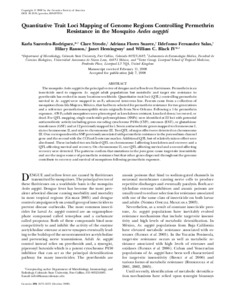Quantitative trait loci mapping of genome regions controlling permethrin resistance in the mosquito Aedes aegypti.
Saavedra Rodríguez, Karla Lizet y Strode, Clare y Flores Suárez, Adriana Elizabeth y Fernández Salas, Ildefonso y Ranson, Hilary y Hemingway, Janet y Black, William C.
(2008)
Quantitative trait loci mapping of genome regions controlling permethrin resistance in the mosquito Aedes aegypti.
Genetics, 180 (2).
pp. 1137-1152.
ISSN 0016-6731
![[img]](http://eprints.uanl.mx/1873/1.hassmallThumbnailVersion/QTL_mapping_of_genome_regions_controlling_permethrin_resistance_in_the_mosquito_Aedes_aegypti.pdf)  Vista previa |
|
PDF
QTL_mapping_of_genome_regions_controlling_permethrin_resistance_in_the_mosquito_Aedes_aegypti.pdf
Download (280kB)
| Vista previa
|
Resumen
The mosquitoAedes aegyptiis the principal vector of dengue and yellow fever flaviviruses. Permethrin is an
insecticide used to suppress Ae. aegypti adult populations but metabolic and target site resistance to
pyrethroids has evolved in many locations worldwide. Quantitative trait loci (QTL) controlling permethrin
survival in Ae. aegypti were mapped in an F3 advanced intercross line. Parents came from a collection of
mosquitoes from Isla Mujeres, Me´xico, that had been selected for permethrin resistance for two generations
and a reference permethrin-susceptible strain originally from New Orleans. Following a 1-hr permethrin
exposure, 439 F3 adult mosquitoes were phenotyped as knockdown resistant, knocked down/recovered, or
dead. For QTL mapping, single nucleotide polymorphisms (SNPs) were identified at 22 loci with potential
antixenobiotic activity including genes encoding cytochrome P450s (CYP), esterases (EST), or glutathione
transferases (GST) and at 12 previously mapped loci. Seven antixenobiotic genes mapped to chromosome I,
six to chromosome II, and nine to chromosome III. Two QTL of major effect were detected on chromosome
III. One corresponds with a SNP previously associated with permethrin resistance in theparasodium channel
gene and the second with theCCEunk7o esterase marker. Additional QTL but of relatively minor effect were
also found. These included two sex-linked QTL on chromosome I affecting knockdown and recovery and a
QTL affecting survival and recovery. On chromosome II, one QTL affecting survival and a second affecting
recovery were detected. The patterns confirm that mutations in the para gene cause target-site insensitivity
and are the major source of permethrin resistance but that other genes dispersed throughout the genome
contribute to recovery and survival of mosquitoes following permethrin exposure.
| Tipo de elemento: |
Article
|
| Materias: |
?? QH301 ?? |
| Divisiones: |
Ciencias Biológicas |
| Usuario depositante: |
Admin Eprints
|
| Creadores: |
| Creador | Email | ORCID |
|---|
| Saavedra Rodríguez, Karla Lizet | NO ESPECIFICADO | NO ESPECIFICADO | | Strode, Clare | NO ESPECIFICADO | NO ESPECIFICADO | | Flores Suárez, Adriana Elizabeth | NO ESPECIFICADO | NO ESPECIFICADO | | Fernández Salas, Ildefonso | ifernand1@hotmail.com | NO ESPECIFICADO | | Ranson, Hilary | NO ESPECIFICADO | NO ESPECIFICADO | | Hemingway, Janet | NO ESPECIFICADO | NO ESPECIFICADO | | Black, William C. | NO ESPECIFICADO | NO ESPECIFICADO |
|
| Fecha del depósito: |
28 Ene 2011 19:38 |
| Última modificación: |
17 Feb 2016 16:37 |
| URI: |
http://eprints.uanl.mx/id/eprint/1873 |
Actions (login required)
 |
Ver elemento |


 Descargar estadísticas
Descargar estadísticas Descargar estadísticas
Descargar estadísticas

